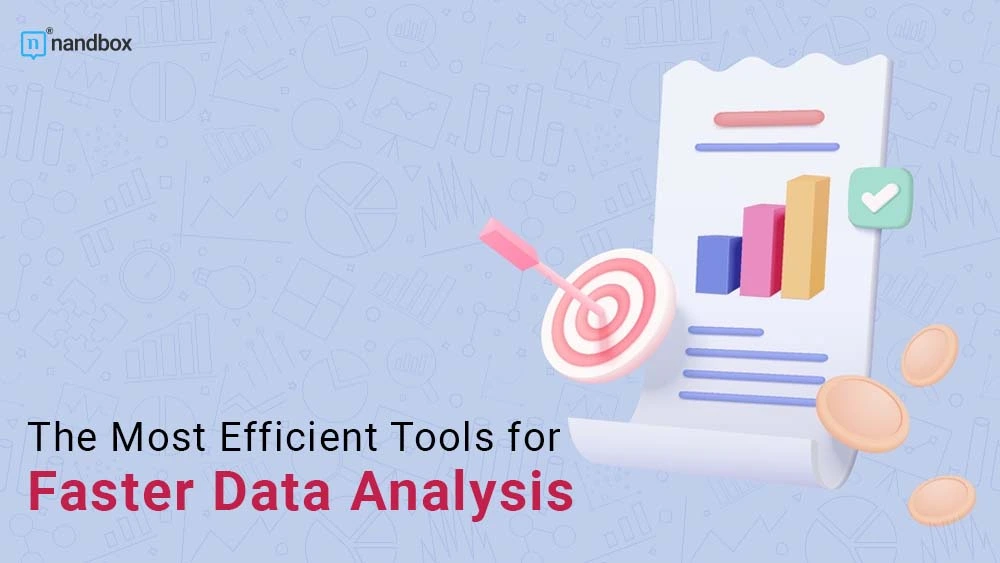Following the recent big data revolution, data analysis became available for companies to make the best use of. Companies now use data to gain an advantage and keep up with the competition. Extensive knowledge about data analytics benefits businesses of every size. That’s why we created this brief guide, which contains an introduction to data analysis, its types, and the best tools for faster data analysis.
What is Data Analysis?
With the help of data analysis, businesses can enhance their offerings and increase customer satisfaction. The goal is to help with decision-making by sifting through large amounts of information. In short, data analytics is the process of analyzing data and making predictions to draw conclusions.
Data analysts analyze and process existing datasets statistically. Data analysts often work on finding new ways to process, capture, and organize information to find useful patterns and correlations that analysts can apply to existing business problems and use cases. Their work also entails using the best approaches to deliver the information they gather in an easy-to-understand language.
Before the big data revolution, data was only available to certain big enterprises, but thanks to machine learning and natural language processing, it has become mainstream.
Types of Data
- Structured data: names and dates, addresses and other contact details, account numbers, and stock data are all examples of structured data. Structured data is highly organized and can be read and understood by computers.
- Data that is neither completely structured nor unstructured is labeled “semi-structured”. It is structured in some way but not according to any predetermined data model or schema, and it may include items that defy conventional categorization.
- Unlike structured data, which follows a predefined data model or schema, unstructured data cannot be stored in a relational database management system (RDBMS). Unstructured content typically takes the form of text and media files. Messages, photos, web pages, and even audio files are all examples of unstructured business documents.
Types of Data Analysis
Data has to be of good quality before it’s usable for businesses. Companies enhance the data before extracting insights from it. After they filter the data, they practice these types of techniques:
1. Descriptive Analysis: It uses calculations of the average, mean, and median to fully understand how the business functions. Organizations implement it by summarizing the collected information to assess sales volume, user base, and growth.
2. Diagnostic Analysis: Once an overall view has been obtained via descriptive analysis, the next step is to identify the motivating factor(s) behind the findings. Analysts get a new perspective on the results by drilling down and filtering the data based on key categories, known as “diagnostic analysis.”
3. Predictive Analysis: It focuses on the future outcome. Data analysts create new machine learning models to detect and showcase trends based on the collected information.
4. Prescriptive Analysis: While the goal of the previous techniques was to gain insights, perspective analysis helps businesses take things to the next level by revealing how alternative courses of action may alter future outcomes.
The Best Tools For Faster Data Analysis
PowerBI
Since the beginning of the data revolution, Microsoft’s PowerBI has been the most popular data analysis tool. Microsoft kept working on the software to ensure it evolved and changed with business needs. It learned its lesson by watching other tools fade out. Power BI has evolved from its humble beginnings as a simple analytics tool to include machine learning capabilities for sentiment analysis tools and seamless integration with other platforms to streamline analytics workflows.
Power BI provides a free desktop version to help individuals learn, while Power BI Pro is available for $10 per user per month for smaller businesses. In addition, Power BI Premium, which offers advanced features like data management and capacity, is available to large businesses for as little as $20 per user per month. Power BI also has a pricing plan based on capacity, rather than per user, for $4,995 per capacity per month.
Tableau
A direct competitor to Microsoft’s PowerBI, Tableau excels in certain areas, like the user interface, ease of use, massive dataset support, and custom visualizations without writing code. On the other hand, PowerBI stands out in other areas because of its resources, Microsoft made it, after all.
Tableau’s server architecture also allows for greater personalization to meet the varying requirements of businesses. Learners and professionals can benefit from Tableau in particular because engaging dashboards can be shared with audiences that do not have Tableau installed.
Tableau has a free tier, but paid upgrades grant access to additional features. Tableau offers a trio of user interfaces: the designer, the explorer, and the viewer. You can only interact with dashboards and visualizations in Tableau Viewer, which costs $15/user/month. Tableau Explorer and Tableau Creator, on the other hand, cost $42 and $70 per user per month to manage data and prepare it, respectively.
Oracle Analytics
Oracle Analytics tool is more than your typical drag-and-drop analytical tool, as it provides AI-based insights based on the data you feed it. Also, with Oracle Analytics, you can easily foresee potential outcomes. Because of its advanced predictive analytics capabilities, Oracle is indispensable to businesses that want to supplement insight delivery with cutting-edge machine learning methods.
Oracle Analytics can supplement your existing data with useful information by pulling in data from reputable public sources to generate new columns, such as the population count of individual states. Moreover, it can turn visual data into text, generating quick insights to help you share it immediately.
Oracle Analytics Cloud offers a selection of pricing tiers to meet the varying needs of its clientele. The premium plans for business and professional versions are available in two tiers, user per month and OCPU per hour. Prices for OCPU vary from $0.3226 per hour to $2.1506 per hour, with per-user monthly plans costing anywhere from $16 to $80.
Coupler.io
Coupler.io is not an alternative to the previously mentioned analytics solutions but rather works in a bundle with them to automate and speed up data analytics processes. The platform allows you to extract data from various business apps, transform it, and send it to the destination app of your choice.
With Coupler.io, you can transfer data you need to analyze to BI tools (PowerBI, Tableau, Looker Studio), databases (BigQuery, PostgreSQL), or spreadsheet apps (Google Sheets, Excel). For example, you connect Facebook Ads to PostgreSQL to perform deep analysis and blend data with ad information from other channels. Prior to importing data into the destination app, you can prepare it by sorting, filtering, adding new columns, or calculating custom metrics — all within Coupler.io functionality.
Coupler.io provides a free plan allowing one active data flow with access to all data sources and destinations. Additionally, there are three paid plans, each offering a 7-day trial. The paid plans, starting at $49 per month when billed annually, offer unlimited data flows.
Conclusion
Understanding data analytics is vital before using any of the many excellent tools. The better you dive in, the more you will reap its benefits for websites and apps. Another data-driven sales strategy is monitoring your website and app’s performance to determine which has more traffic. Experts would say that mobile apps usually allow for more exposure than websites. And creating a mobile app has never been easier with no-code solutions. If you want to build a mobile app effortlessly and save thousands of dollars, look no further than the nandbox native no-code app builder. Sign up and start using it now!






